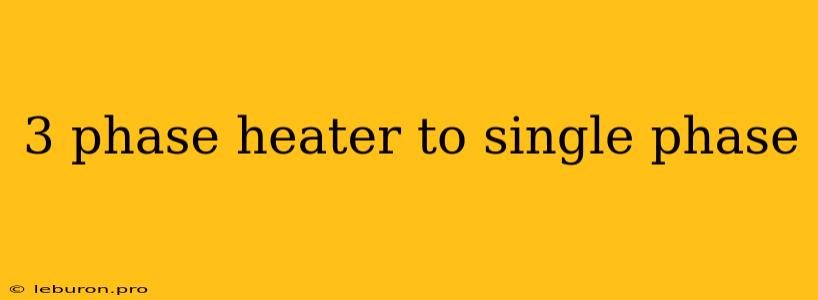Converting a three-phase heater to single-phase operation can be a practical solution when dealing with limited electrical infrastructure or the need to utilize existing single-phase power supply. While it may seem like a straightforward process, it requires careful consideration of several factors and specific modifications to ensure safe and efficient operation. This article will delve into the intricacies of this conversion process, providing a comprehensive guide for understanding the technical considerations, potential challenges, and recommended steps involved.
Understanding the Differences: Three-Phase vs. Single-Phase
Before embarking on the conversion process, it's crucial to understand the fundamental differences between three-phase and single-phase power systems.
Three-phase systems are characterized by three alternating current (AC) waveforms, each offset by 120 degrees. This creates a rotating magnetic field, making them suitable for powering high-power equipment like motors and industrial heaters.
Single-phase systems only have one AC waveform, resulting in a pulsating magnetic field. While simpler and more common for residential use, they generally have lower power capacity compared to three-phase systems.
Challenges of Converting a Three-Phase Heater to Single-Phase
Converting a three-phase heater to single-phase presents several challenges:
Reduced Power Output:
One of the most significant issues is a reduction in power output. Single-phase systems typically have lower current and voltage capabilities than their three-phase counterparts. Consequently, a three-phase heater connected to a single-phase system will produce less heat. This decrease in power output might not be sufficient for the intended application, particularly in high-demand situations.
Increased Resistance and Heat Dissipation:
Converting a three-phase heater to single-phase often involves connecting the heating elements in series or parallel configurations. This can lead to increased resistance within the system, which in turn increases the heat dissipation within the heater. This could potentially cause overheating and damage the elements, requiring careful consideration of the specific heater's design and the chosen configuration.
Potential for Unbalanced Loading:
In a three-phase system, the load is evenly distributed across all three phases. However, when converting to single-phase, the entire load is placed on a single phase, potentially creating an unbalanced condition. This imbalance could lead to voltage fluctuations, increased current draw, and reduced efficiency.
Methods for Converting a Three-Phase Heater to Single-Phase
There are two primary methods for converting a three-phase heater to single-phase:
1. Series Connection:
In this method, the three heating elements are connected in series. This effectively increases the resistance, but also reduces the overall current draw. This method is generally suitable for lower power heaters, where the reduction in power output is acceptable.
Advantages:
- Reduced current draw, potentially allowing for use with smaller single-phase circuits.
Disadvantages:
- Significant reduction in power output, making it unsuitable for high-power applications.
- Increased resistance leading to higher heat dissipation, potentially causing overheating issues.
2. Parallel Connection:
Connecting the heating elements in parallel provides a lower resistance path for the current to flow. This allows the heater to draw more current and potentially operate at a higher power level compared to the series connection.
Advantages:
- Higher power output compared to series connection.
Disadvantages:
- Higher current draw, potentially exceeding the capacity of the single-phase circuit.
- Increased risk of overheating due to increased current flow.
Important Considerations for Conversion
- Voltage Compatibility: Ensure the single-phase supply voltage matches the heater's rated voltage.
- Current Capacity: The single-phase circuit must be able to handle the current draw of the converted heater.
- Heating Element Ratings: Consider the individual heating element ratings and their compatibility with single-phase operation.
- Safety Measures: Implement appropriate safety measures, such as overcurrent protection devices, to prevent overheating and potential hazards.
Alternative Solutions
Instead of directly converting a three-phase heater, consider exploring these alternative options:
- Replacing the Heater: Investing in a new heater designed for single-phase operation might be the most efficient and safe solution.
- Using a Three-Phase to Single-Phase Converter: Specialized converters are available that can provide a three-phase output from a single-phase input, allowing the heater to operate as intended. However, these converters can be expensive and may not be practical in all situations.
Conclusion
Converting a three-phase heater to single-phase operation is a viable option in certain circumstances, but it requires careful consideration and a thorough understanding of the technical challenges involved. Choosing the appropriate connection method, ensuring compatibility with the single-phase supply, and implementing safety measures are critical aspects for a successful conversion. Ultimately, the feasibility and practicality of the conversion depend on the specific heater, the available single-phase power supply, and the intended application. Before attempting any modifications, consulting with a qualified electrician is strongly recommended to ensure safety and proper operation.
